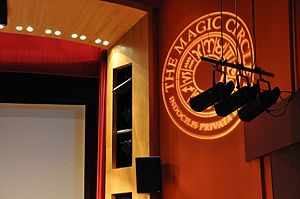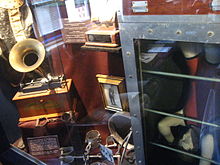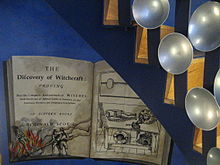- The Magic Circle
-
The Magic Circle 
The Magic Circle TheatreMotto Indocilis Privata Loqui
(not apt to disclose secrets)Formation 1905 Purpose/focus To promote and advance the art of magic Headquarters 12 Stephenson Way, Euston Location London, UK Coordinates 51°31′35″N 0°08′08″W / 51.52639°N 0.13556°WCoordinates: 51°31′35″N 0°08′08″W / 51.52639°N 0.13556°W Membership ~1,450 Official languages English President Jack Delvin Main organ Elected Council Website TheMagicCircle.co.uk The Magic Circle is a British organisation, founded in London in 1905, dedicated to promoting and advancing the art of magic.[1]
Contents
History
The Magic Circle was founded in 1905 after a meeting of 23 amateur and professional magicians at London's Pinoli's Restaurant. At this founders meeting, chaired by Servais Le Roy, those present decided upon the name of the Society — it was initially felt that the name of the Society should be the Martin Chapender Club, in memory of the noted performer, and founding member, who had recently died at the age of twenty-five. However, it was then agreed that the name "Magic Circle" would be more appropriate and that this name shared the same initials as those of Martin Chapender.[2] The first official meeting was at the Green Man public house in Soho, but meetings were later in a room at St George's Hall in Langham Place, where David Devant and John Nevil Maskelyne were regularly seen performing.[3]
Devant became the first president of The Magic Circle, and in 1906, Maskelyne edited the first issue of The Magic Circular magazine, a regular feature for members ever since. The Magic Circular claims to be the longest running regular magic magazine in conjuring history.
The club was male-only until 1991, when more than 75% of members voted to admit women. There are around eighty female members of The Magic Circle, including Paul Daniels' wife, Debbie McGee.[2]
Motto
The motto of the society is the Latin indocilis privata loqui, roughly translated as "not apt to disclose secrets"; members give their word not to wilfully disclose magic secrets other than to bona fide students of magic. Anyone breaking this or any other rule may be expelled.
Headquarters
Since 1998, The Magic Circle building in central London near Euston Station in Camden has been available for meetings and corporate entertainment. It was voted the UK's Number One Venue in the hospitality industry's Top 20 UK Venues poll 2008.
The Magic Circle's headquarters houses a theatre, libraries, a dining room, a clubroom and bars.
The Magic Circle Museum
The museum features magic tricks, props, posters, programs, toys, photographs and artefacts related to magic and illusionists. Items of interest include, Robert Harbin’s original Zig Zag lady illusion, Chung Ling Soo's robes, rifles used for the ‘Bullet Catch’ by Maurice Fogel in the 1940s, sets of props used by television magicians David Nixon and Tommy Cooper, items and a sound recording of Harry Houdini taken from an Edison cylinder, and a set of cups and balls used by HRH The Prince of Wales when he took his Magic Circle exam in 1975. Visits are by arranged tour.[2]
Membership[4]
Magicians who wish to join need to have known two current members for a least one year and must be at least 18 years old. These two members are then asked to act as sponsors, or referees, on the candidate's application form and propose him or her as a suitable candidate for membership. Following the receipt and processing of the application, the candidate is invited to an interview with the examinations secretary, usually at the London headquarters. If the candidate proves suitable and sufficiently knowledgeable a performance exam is scheduled or a thesis may be written. The exam takes place in front of a panel of judges, and the candidate must demonstrate their skills to members in a rehearsed act.
A thesis is read by two examiners and a copy is made available in The Magic Circle library. The final stage is by vote by members of the Council, who will approve the candidate as a member. Once the applicant is successful, they are free to call themselves "Members of the Society" and use the letters M.M.C. after their name.
There are approximately one-thousand five-hundred members (including Charles, Prince of Wales, David Copperfield, Ken Dodd, Steve Allen (radio presenter), Wayne Dobson, Charlotte and Jonathan Pendragon, Siegfried and Roy, Michael Vincent, Dynamo, Nigel Mansell, John Archer and John MacGregor, Baron MacGregor of Pulham Market), in more than forty countries.
Members may take a further examination to achieve the degree of Associate of the Inner Magic Circle. The designation A.I.M.C. shows this higher membership. The A.I.M.C. degree can also be attained through thesis, and in rare cases - that is when a candidate gains 18 or higher out of a possible 20 marks in the written exam - examinees taking the M.M.C. exam are awarded the A.I.M.C. degree. Those who attain an A.I.M.C. degree as a result of a performance examination are awarded the A.I.M.C. with silver star.
Within the society, there are a number of members never exceeding three-hundred known as the "Inner Magic Circle". Full membership of the Inner Magic Circle is denoted by the letters M.I.M.C. after the member's name. Membership of the Inner Magic Circle is by call of The Society's President. The M.I.M.C. degree may be awarded with a gold star, in recognition of the holder's excellence as a performer, although not all holders of the M.I.M.C. degree are performers, and hence, not all are M.I.M.C. with gold star.
The Young Magicians Club
The Young Magicians Club (YMC) is a club for magicians under the age of 18 who are sponsored by 'The Magic Circle' which was founded in 1996. The group meets at The Magic Circle Headquarters, the 'Centre for the Magic Arts' in London.[5] The Young Magicians Club has a current membership of more than 500 members.[6]
The Young Magicians Club's principal means of communication among its members is its bi-monthly magazine "'Secrets'". The worldwide membership also communicates through a members-only on-line forum on the YMC website.
Unlike The Magic Circle and other magic societies, membership of The Young Magicians Club requires no interview or exam and is open to all young people interested in magic. There are monthly all-day workshops for members who come from all over the country to take part. Adult members of the Magic Circle take on the responsibility of instructing the members of The Young Magicians Club. Local adult magic clubs will usually have a Young Magicians Club attached to it. Members of the The Young Magicians Club are eligible to join The Magic Circle at a discounted rate when they reach 18, but they must still face the rigorous examination procedure.
The Young Magicians Club holds their annual one-day convention every October called 'J-Day'. The convention includes lectures and the finals of two competitions with awards, which include the Peter McCahon Award for Originality and the Kaymar Komedy Cup. In 2010, the lecture was presented by Derren Brown and in 2011, Dynamo.
The popularity of the Harry Potter franchise has been one of the key reasons for the organisation's growth in the past few years, with memberships doubling after the announcement of the first film in 2001.[6]
See also
- American Museum of Magic
- List of magic museums
References
- ^ Jack Delvin. "About The Magic Circle". http://www.themagiccircle.co.uk/about-the-club.
- ^ a b c Soteriou, Helen (MAY 5, 2010). "Inside The Magic Circle Of London". Londonist. http://londonist.com/2010/05/inside_the_magic_circle_of_london.php. Retrieved 2010-01-22.
- ^ Magic Circle Magician FAQ.
- ^ "The Magic Circle guide to examiniation". http://www.themagiccircle.co.uk/attachments/193_193_GuideFullRevised.pdf.
- ^ The Young Magicians Club
- ^ a b Wallace, Sam; Hall, Macer (2001-06-19). "Harry Potter conjures wave of Magic Circle applications". London: The Telegraph. http://www.telegraph.co.uk/news/uknews/1367811/Harry-Potter-conjures-wave-of-Magic-Circle-applications.html. Retrieved 2008-07-19.
Further reading
- Tim Hulse, 'Magicians fight to make each other vanish', The Independent. September 6, 1998. Retrieved via subscription 1 March 2008.
- Sam Wallace and Macer Hall, 'Harry Potter conjures wave of Magic Circle applications'. The Daily Telegraph, June 19, 2001. Retrieved 1 March 2008.
- 'Now, is that magic?', BBC News, October 14, 2005. Retrieved 1 March 2008.
- Simon O'Hagan, Secret London: Tricks and treats, The Centre for the Magic Arts', The Independent on Sunday, June 15, 2003. Retrieved via subscription 1 March 2008.
External links
Magic organizations Society of American Magicians • International Brotherhood of Magicians • Society of Young Magicians • The Magic Circle • American Museum of Magic • Academy of Magical Arts • Canadian Association of Magicians • Shore City Magicians Club • Young Magicians' Club • Fédération Internationale des Sociétés Magiques • College of Magic • Conjuring Arts Research Center • Magic Youth InternationalMagic and illusion General Mentalists · Assistants · Exposure · Sleight of hand · Magic club · Magic conventions · Equivocation · Misdirection · Magic Allied Arts
Genres Card · Gospel · Torah · Micromagic · Platform · Parlor · Children's · Street · Theatrical séance · Escape · Coin · Mental · Bizarre · Stage illusions · MathemagicTricks Lists Timeline · Conjuring terms · Manufacturers · Magicians · Magic tricks · Magic publications · Magic museums · Films about magiciansMagic history Categories:- Buildings and structures in Camden
- Clubs and societies in the United Kingdom
- Magic museums
- Magic organizations
- Organizations established in 1905
- Performing arts museums
- Museums in Camden
- Theatres in Camden
Wikimedia Foundation. 2010.


